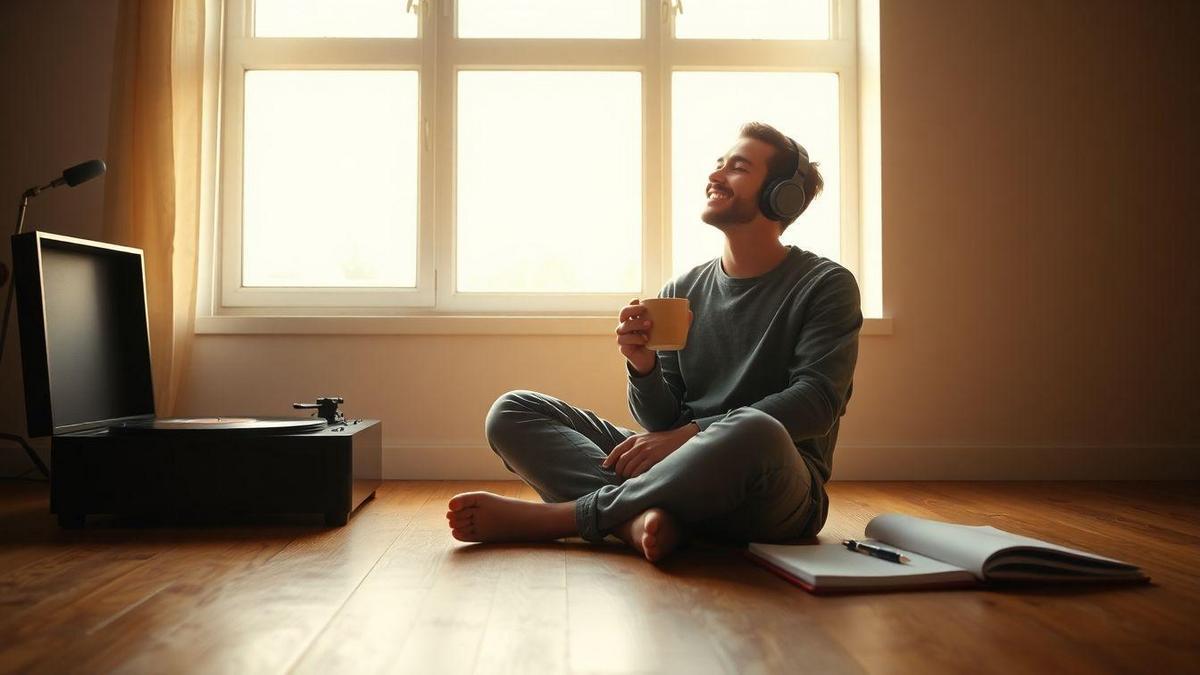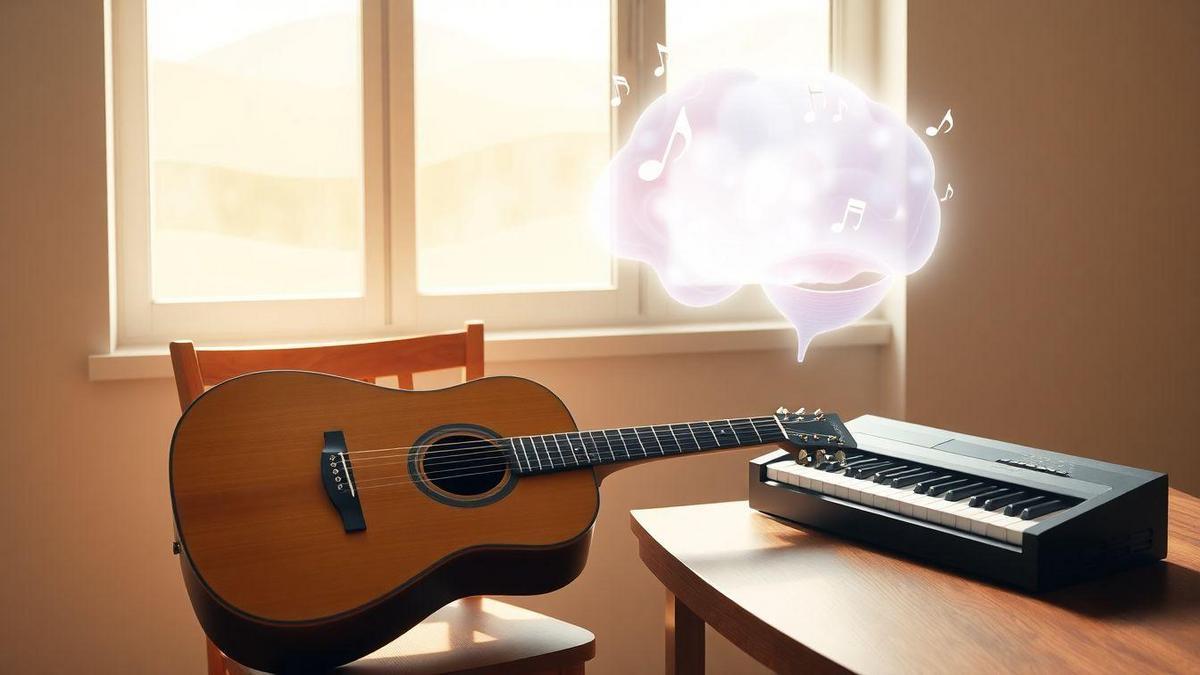Music as therapy: how playing helps clear your mind
I speak from what has helped me. I use music to calm heavy feelings and clear my head. Below I share simple, repeatable habits I use: gentle breathing with sound, short mindful playing, easy rhythm exercises, and small improv moves that lift my mood — all paired with a simple practice routine I follow most days. Playing with others makes me feel less alone and more confident. I also touch on how this practice changed my brain and sharpened my focus, so you can try these ideas too. This is a practical guide to Music as therapy: how playing helps clear your mind.
Key takeaways
- I feel calmer when I play music.
- I clear my mind by focusing on rhythm and breath.
- Short sessions ease stress and sharpen focus.
- Playing with others builds connection and confidence.
- I sleep better after I make music.

How I use music to calm strong feelings
I turn to music when feelings feel too big. I play, sing, or listen to calm my body and clear my head. Music becomes a soft anchor that keeps me steady.
Why music therapy for emotional regulation works
Playing slows my breath and gives words to emotion. When I play a slow chord my breath slows; when I sing a phrase anger becomes language I can hold. Research backs this: music can lower stress hormones and boost mood. Five minutes of focused playing often eases my chest and settles my thoughts. This is a core example of Music as therapy: how playing helps clear your mind.
How playing instruments reduces stress
Playing an instrument gives me a simple task and a break at once: my hands focus, my mind follows. The inner noise turns into sound outside — a shift that releases tension.
If you aren’t sure which instrument to try first, I found it helpful to read guidance on how to choose your first instrument without regrets.
| Instrument | What I do | Effect |
|---|---|---|
| Guitar | Strum slow chords | Calm, slower breath |
| Piano | Play simple patterns | Focus, clears clutter |
| Drums | Tap a steady beat | Grounded, releases anger |
Small, effective steps I use
- Start with 2–5 minutes of simple playing — often enough to shift mood.
- Choose one anchor (a chord, a scale, a lyric) and return to it when scattered.
- Set a short goal: one verse, one riff, one beat. Small goals build confidence.
- Breathe with the music; count notes to steady breath.
- Keep a quick log of what helps so patterns show up.
| Step | Time | What I notice |
|---|---|---|
| Quick play | 2–5 min | Breath slows |
| Anchor return | 1–2 repeats | Thoughts clear |
| Small goal | 5–10 min | Mood lifts |
These steps align with many ideas for creating a daily plan — see a practical simple practice routine if you want a starting template.
Music as therapy: how playing helps clear your mind when I’m tense
Active music making shifts attention from worry to sound. Strike a chord or tap a rhythm and your breath and heartbeat often find a steadier pace. That simple change pushes stress to the edges of attention. Playing also gives a safe outlet: soft when fragile, loud when releasing anger — restoring a sense of agency.
Simple actions that reduce stress
| Action | Change for me | Time |
|---|---|---|
| Play steady rhythm (metronome/tap) | Mind steadies | 2–5 min |
| Hum or sing | Breath and mood lift | 1–3 min |
| Improvise | Release emotion | 5–15 min |
| Play familiar song | Comfort and calm | 1–7 min |
Small tools I use: scale practice to center, a short call-and-response with a recording, and playing with others for fast stress relief.
A five-minute reset routine
I call this my “five-minute reset.”
- Sit comfortably and take three slow breaths.
- Tap a steady beat for 30–60 seconds.
- Play a simple scale or chord progression once through, softly.
- Improvise for 1–2 minutes. Let mistakes be okay.
- Hum the last note and breathe out.
This fits between meetings and often clears my head and brings my focus back quickly.

Music as mindfulness to stay present
I use music to pull me into the present with a simple rule: listen and breathe. Start with breath: inhale 4, exhale 6. Match sound to breath — hum on the exhale and let it fade. Keep the habit short: one note, one chord, notice bodily sensations.
| Step | Action | Why it matters |
|---|---|---|
| 1 | Breathe 4 in / 6 out | Calms heart rate |
| 2 | Hum or play one note | Anchors attention |
| 3 | Notice sensations | Stops mind wandering |
Short, repeated actions build momentum — slow scales strengthen attention and make it easier to return to the sound when the mind drifts. For complementary guidance on breathing and relaxation, try Guided relaxation techniques and breathing.
Rhythm and relaxation therapy
When my chest is tight I use rhythm — tap a drum or my leg and breathe with the pulse. Tempo choices matter: slow to calm, medium to focus, fast to burn off energy.
For a concise overview of how music-based activities support emotional regulation and social connection see this Overview of music therapy and benefits.
| Beat type | Tempo | Effect | How I use it |
|---|---|---|---|
| Slow pulse | 50–70 BPM | Calms heart & breath | Tap with both hands, long breaths |
| Mid pulse | 80–100 BPM | Focuses attention | Simple patterns 5–10 min |
| Syncopated | 100–120 BPM | Releases tension | Short bursts, then slow down |
Simple rhythm exercises I use anywhere:
- Box beat: four even taps; inhale two taps, exhale two; repeat 2–5 min.
- Call-and-response: play a short phrase, echo it softer; 3–7 min.
- Heartbeat mimic: short-short-long taps; match pulse and slow it; 1–3 min.
What I learned about the neural effects
Playing changes more than mood. When I play, my breath slows, my thoughts calm, and I get a small mood lift — consistent with studies showing increased reward activity (dopamine), more alpha/theta waves (calm focus), and rhythmic entrainment (steady heartbeat). In plain terms: sound nudges circuits — fast rhythms wake motor areas, gentle melodies soothe emotional centers, and repetition trains connections. See one comprehensive review on Research on music’s reward and brain for more on these neural mechanisms.
| Finding | What I felt | Why it matters |
|---|---|---|
| Increased reward activity | Joy, motivation | Makes practice stick |
| More alpha/theta waves | Calm focus | Reduces rumination |
| Improved connectivity | Faster stress recovery | Better coping |
| Rhythmic entrainment | Steadier heartbeat | Helps flow |
I apply these findings with short routines: warm up with a slow melody, use steady rhythm when scattered, play familiar tunes to trigger reward, improvise for flexibility, and repeat focused drills to strengthen connections.
Cognitive benefits for clearer thinking
I treat music practice as a brain tune-up. Repeating the phrase “Music as therapy: how playing helps clear your mind” before I start reminds me why I play. Regular practice improves memory and attention: repeating short phrases locks tunes into memory; slow practice builds long-term retention; playing from memory strengthens uninterrupted focus.
| Practice action | Memory gain | Attention gain |
|---|---|---|
| Repeat short phrases | Better recall | Easier to stay on task |
| Slow practice | Stronger long-term memory | Fewer distractions |
| Play from memory | Confidence remembering | Longer focus |
Daily habits: warm-up 5 minutes, chunk practice into 10–15 minute sections, mindful listening for 5 minutes, and record a short run to listen back. Small, steady practice beats long, scattered sessions. For a readable summary of research linking music to attention and memory, see Evidence on music’s cognitive brain benefits.
Improvisation to loosen the mind
When I feel stuck I pick up my instrument and improvise. Improv clears my head and makes space for ideas. My approach: set tiny goals (1–2 minutes), accept mistakes, record one take and keep it, and add one new note or rhythm each session. This turns fear into curiosity.
If improvisation feels risky at first, learning a bit of music theory and songwriting basics made improv feel safer and gave me simple patterns to explore.
| Exercise | Time | Mood effect |
|---|---|---|
| Single-note humming | 2 min | Calms breath, eases anxiety |
| Call-and-response | 5 min | Builds focus and play |
| Rhythm tapping | 3 min | Grounds body, lifts energy |
| Free one-chord jam | 5–10 min | Reduces overthinking |
A short creative warm-up: breathe 4/6, hum a pitch for three breaths, tap a steady beat, play a safe scale slowly, whisper a silly phrase and match its rhythm on the instrument. Five minutes primes body, ears, and imagination.
Confidence and personal growth through practice
I celebrate tiny victories: a clean chord change, one steady minute, a short honest improv. I log these wins to see progress; they build confidence and make practice feel like proof of growth.
| Small win | What I do | Why it helps |
|---|---|---|
| Clean chord change | Slow practice x10 | Builds muscle memory and trust |
| One-minute steady tempo | Metronome 60s | Strengthens focus & calm |
| Short improv line | Play for 30s | Sparks creativity and joy |
Playing with others: shared rhythm, shared calm
I live by one truth: playing music with others clears my head. Group playing shifts attention from internal worry to shared sound. Rhythm becomes an anchor; listening replaces ruminating. A nod or smile from another player tells me I belong. Music turns solo stress into shared focus.
The American Music Therapy Association gives a helpful explanation of How music therapy builds social connection and why group music-making supports emotional regulation.
Group exercises I use:
- Call-and-response (5–10 min) — focus and connection.
- Breath-and-tone (3–5 min) — breathe together and hold a tone for calm.
- Simple pulse (5 min) — everyone taps a steady beat to feel centered.
Before playing with others I check my instrument, drink water, do a two-minute breathing break, and set a simple intention: Listen, breathe, be present.
Conclusion
I keep it simple because it works. Music as therapy: how playing helps clear your mind is practical: a quick path to calm, clearer focus, and steadier breath. A few minutes of rhythm, a short improv, or a familiar song can reset a crowded head. Tiny, repeatable habits (2–5 minutes, one anchor, small goals) build confidence and reshape how the brain meets stress. Playing with others adds warmth and connection; it turns private worry into shared rhythm.
For more ideas and short routines, try a simple daily practice plan, learn about our approach on the About page, or get in touch.

8 comentários em “Music as therapy how playing clears mind”